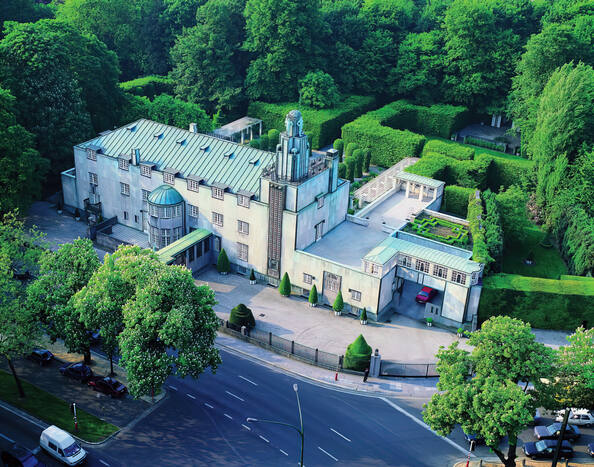Palacio Stoclet
Stoclet House
When banker and art collector Adolphe Stoclet commissioned this house from one of the leading architects of the Vienna Secession movement, Josef Hoffmann, in 1905, he imposed neither aesthetic nor financial restrictions on the project. The house and garden were completed in 1911 and their austere geometry marked a turning point in Art Nouveau, foreshadowing Art Deco and the Modern Movement in architecture. Stoclet House is one of the most accomplished and homogenous buildings of the Vienna Secession, and features works by Koloman Moser and Gustav Klimt, embodying the aspiration of creating a ‘total work of art' (Gesamtkunstwerk). Bearing testimony to artistic renewal in European architecture, the house retains a high level of integrity, both externally and internally as it retains most of its original fixtures and furnishings.
Description is available under license CC-BY-SA IGO 3.0
Palais Stoclet
Le Palais a été conçu en 1905 à la demande du banquier et collectionneur Adolphe Stoclet par l'un des chefs de file du mouvement artistique de la Sécession viennoise, l'architecte Josef Hoffman. Ce dernier a pu travailler sans limite financière ou esthétique. Avec leur géométrisme épuré, le palais et le jardin (terminés en 1911) marquent un changement radical au sein de l'Art nouveau, changement qui annonce l'Art déco et le mouvement moderniste en architecture. Le Palais Stoclet est une des réalisations les plus abouties de la Sécession viennoise. Il abrite des œuvres de Koloman Moser et de Gustav Klimt, liées à la conception du Gesamtkunstwerk (architecture, sculpture, peinture et arts décoratifs s'intègrent dans une même œuvre). Le Palais témoigne du renouveau artistique de l'architecture européenne et présente un haut niveau d'intégrité dans ses dimensions d'architecture extérieure, d'architecture et de décoration intérieures, avec des meubles et objets originaux.
Description is available under license CC-BY-SA IGO 3.0
اسْتوكلِت هاوس
عندما قرر المصرفي ومُجمّع التحف الفنية، أدولف اسْتوكلِت، تكليف أحد أبرز المهندسين المعماريين المنضمين إلى حركة الانفصال الفنية في فيينا، وهو جوزيف هوفمان، في عام 1905، ببناء هذا القصر، فإنه لم يفرض أية قيود جمالية أو مالية لتنفيذ مشروع البناء. وقد اُستكمِل بناء القصر وإقامة الحديقة الملحقة به في عام 1911. ويُعد التصميم الهندسي للقصر والحديقة، الذي يخلو من أي زينة، نقطة تحول في حركة الفن الجديد التي مهدّت السبيل لظهور طراز "الأرت ديكو" والحركة الحديثة في الفن المعماري. ويُعتبر اسْتوكلِت هاوس أحد أكثر الأبنية اكتمالاً وتجانساً التي تتماشى مع أسلوب حركة الانفصال الفنية في فيينا، كما أنه يُبرز أعمال كولومان موسير وجوستاف كليمت، من خلال تجسيد الطموحات الرامية إلى خلق "عمل فني تام" (Gesamtkunstwerk). وما زال هذا القصر، الذي يشهد على حركة فنية تجديدية في الهندسة المعمارية الأوروبية، سليم البنيان إلى حد بعيد، من الداخل والخارج على السواء، حيث بقت معظم عناصره الثابتة وأثاثه على حالها الأصلية.
source: UNESCO/CPE
Description is available under license CC-BY-SA IGO 3.0
Palacio Stoclet
En 1905, cuando Adolphe Stoclet, banquero y coleccionista de obras de arte, encargó la construcción de este edificio a Josef Hoffmann, uno de los arquitectos más destacados del movimiento denominado Secesión de Viena, no le impuso condiciones estéticas ni financieras de ningún tipo. La finalización en 1911 de este palacio y su jardín, caracterizados por su geometría austera, fue un momento decisivo en la historia del Art Nouveau que anunciaba ya la arquitectura del Art Déco y el Movimiento Modernista. El Palacio Stoclet es una de las edificaciones más logradas y homogéneas de la Secesión de Viena, cuenta con obras de Koloman Moser y Gustav Klimt, y encarna la ambición de crear la “obra de arte total” (Gesamtkunstwerk), en la que arquitectura, escultura, pintura y artes decorativas se integran en una misma obra. Este edificio es un testimonio de la renovación artística de la arquitectura europea. Su estado de conservación es excepcional, ya que se han preservado intactas la mayoría de las instalaciones y del mobiliario originales.
source: UNESCO/CPE
Description is available under license CC-BY-SA IGO 3.0
ストックレー邸
銀行家で美術品収集家でもあるアドルフ・ストックレーは、1905年、邸宅の建築をウィーン分離派運動の先駆的建築家ジョセフ・ホフマンに依頼した。芸術的にも金銭的にも制約を受けることなく、邸宅と庭園は1911年に完成した。単純化された幾何学的な設計はアールヌーボーの転換点として注目され、アールデコや建築におけるモダニズム運動の端緒となった。邸宅はウィーン分離派の最も完全で均整のとれた建築のひとつで、“総合芸術”の確立を目指したコロマン・モーゼルやグスタフ・クリムトの作風が取り込まれている。ほとんどの設備や家具什器が当時のまま残されており、外観・内装ともに全体が良好に維持されている。source: NFUAJ
Stoclet huis
Bankier en kunstverzamelaar Adolphe Stoclet gaf in 1905 Josef Hoffmann – een van de belangrijkste architecten van de Weense Secessie-beweging – de opdracht dit huis te bouwen. Het huis en de tuin werden voltooid in 1911 en hun strakke geometrie betekende een keerpunt in de Art Nouveau en een voorbode van de Art Deco en de Moderne Beweging in de architectuur. Het Stoclet huis – met werk van Koloman Moser en Gustav Klimt – is een van de meest succesvolle gebouwen van de Weense Secessie. Het belichaamt het streven naar een ‘totaal kunstwerk’ (Gesamtkunstwerk) en getuigt daarmee van artistieke vernieuwing in de Europese architectuur.
Source: unesco.nl
